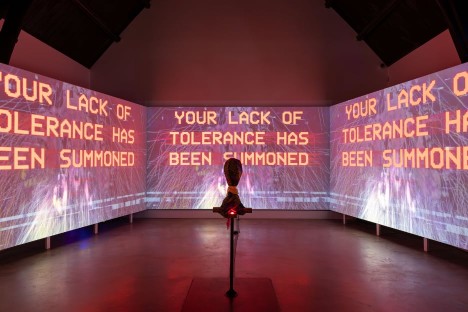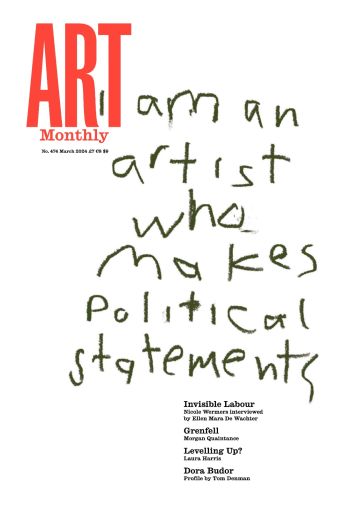Review
Danielle Brathwaite-Shirley: THE REBIRTHING ROOM
Hannah Hutchings-Georgiou on a video-game installation that provides a traumatic but transformative experience

Danielle Brathwaite-Shirley, THE REBIRTHING ROOM, 2024
‘Warning! A Rebirthing Room has Opened Here’ reads the sign outside Danielle Brathwaite-Shirley’s latest exhibition. Bracing myself for the experience ahead, I part the brightly coloured curtains upon which multiple pairs of glowing eyes stare eerily back at me. This ominous motif, one common to Brathwaite-Shirley’s animations and videogames, is a foretaste of what’s to come. For although I’m about to enter a realm shrouded in darkness, an alternate world where day is always night and the forest of my fears will come alive, THE REBIRTHING ROOM, 2024, is a space that surreally turns what you view back onto yourself. The process of rebirth is then as much about the mind – or the mind’s eye – as it is the body.
Standing under a psychic canopy of cloth-clad boughs and long grass, with an unnerving sound-score rumbling underneath, we are invited to confront our ‘anxiety’, ‘low self-esteem’, ‘fear of failure’, ‘addictions’, ‘self-doubt’ and ‘intolerance’, all of which are monstrously portrayed on the three screens at the far end of the ‘room’. Using the ‘anchor’, a ghoulish, material-wrapped, head-shaped console that also invokes the uncanny, visitors take turns at tackling these inhibitions. Every attempted assault on our own projected issues almost always results in loss; there is no escape from or triumph over our most vulnerable and fragile sense of self. But this is precisely Brathwaite-Shirley’s point: it’s not in the vanquishing of our insecurities but in the painful recognition of them that the rebirthing process begins. Turning the viewer’s passive gaze into one of active, participatory introspection through game-playing and instructive texts, Brathwaite-Shirley recreates therapeutic practices and spaces, as well as the embodied response to both. The result is a rebirth as traumatic as it is truly transformative.
Of course, the ‘rebirthing room’ in question is not exactly a room per se. Christened a ‘Pro Black/Pro Trans Space’ – one, it must be added, that was a former Mission Hall in the 1890s and is now a converted gallery – the ‘room’ could be seen as a congregational and confessional site, as well as an area of delivery and natal intent. Using her practice to bring people together, particularly those from the black trans community, Brathwaite-Shirley creates a unique locale that is as much about communal dwelling and collective healing as it is about a church-like battling of inner demons. In fact, for all its use of lo-fi glitching graphics of luridly coloured apparitions and grotesque ghosts, THE REBIRTHING ROOM is not a sanctum of exorcism in a Catholic or Pentecostal sense, rather, the artist’s reclamation of religious architecture, iconography, terminology and philosophy – to be reborn is to be saved by the Son of God in Christianity, after all – is a subversive statement about salvation itself. Though trans individuals may undergo a kind of rebirthing process of their own, in no way are they in need of being saved, nor are they in need of being converted (in any sense of the word). The chapel-like, salvational atmosphere Brathwaite-Shirley channels is one that allows black trans individuals to be and to feel, to recognise hurt and to heal together.
It is this ethic of collective care for black trans people that Brathwaite-Shirley has sown in past works. Videogames such as BlackTransArchive.com, which was co-designed by black trans collaborators specifically for black trans participants, posits a quest through surreal and textured worlds in search of black trans ancestors, knowledge, healing and belonging. In this, THE REBIRTHING ROOM is no different. Ancestors may not be brought back from the depths of the earth, but experiences familiar to black trans participants are resurrected and worked through in a safe, albeit disconcerting, space. True to her praxis, Brathwaite-Shirley re-envisages the room as a living, embodied archive, one where the technology and psychology of the self are pushed, and the stresses and distresses that are but one part of the trans experience can be grappled with and explored. Encountered by diverse viewers, cis and trans alike, this living, breathing, interactive, fabulously fabricated and ghostly archive becomes an unfolding zone in which to reimagine, reconnect, record and rebuild our own sense of self, insecurities and all. The self and future we birth together – warts and all – is what matters. What we see of ourselves in the other, but even more so. At once a thrilling and chilling multimedia extravaganza, THE REBIRTHING ROOM delivers more than old emotions manifested anew, but labours ways of seeing, thinking and being – an internal birth we are invited to undergo as well as behold.
‘Danielle Brathwaite-Shirley: THE REBIRTHING ROOM’, Studio Voltaire, London, 31 January to 28 April 2024.
Hannah Hutchings-Georgiou is a writer, researcher and editor.
First published in Art Monthly 474: March 2024.









